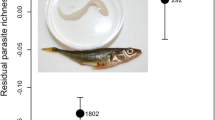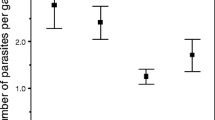Abstract
In parasites with a complex life cycle, the fitness of an individual depends on its probability of reaching the final host and on its fecundity. Because larval growth in intermediate hosts may affect both transmission and adult size, selection should optimize growth patterns that are conditional on the presence and number of conspecific competitors. A recent model predicts that the total parasite volume per host should increase with intensity if larvae are able to vary growth depending on the number of conspecifics in the host (Life History Strategy hypothesis, i.e. LHS). Further, we would here expect growth rates to increase with intensity. By contrast, under the simplest alternative hypothesis of Resource Constraints (i.e. RC), the total parasite volume should remain constant. We experimentally infected copepods Macrocyclops albidus with the cestode Schistocephalus solidus to achieve 1, 2 or 3 parasites per host taking care that hosts had similar quality status at each infection level, and compared larval growth trajectories at the three intensity levels. The asymptotic total parasite volume was larger in double and triple infections than in single infections. Furthermore, the asymptotic total parasite volume was significantly larger in triple than in double infections but only in larger copepods that were less constrained by a host-size ceiling effect. These results, together with the fact that growth rates increased with intensity, support the LHS hypothesis: procercoids of a tapeworm may “count” their conspecific competitors in their first intermediate host to harvest its resources strategically until the next step in their complex life cycle.
Similar content being viewed by others
References
J.D. Arendt (1997) ArticleTitleAdaptive intrinsic growth rates: an integration across taxa Quart. Rev. Biol. 72 149–177 Occurrence Handle10.1086/419764
Bush, A.O., Fernández, J.C., Esch, G.W. and Seed, R.J. (2001) Parasitism: The Diversity and Ecology of Animal Parasites. Cambridge University Press.
M. Choisy S.P Brown K.D. Lafferty F. Thomas (2003) ArticleTitleEvolution of trophic transmission in parasites: why add intermediate hosts? Am. Nat. 162 172–181 Occurrence Handle10.1086/375681 Occurrence Handle12858262
M. Christen J. Kurtz M. Milinski (2002) ArticleTitleOutcrossing increases infection success and competitive ability: experimental evidence from a hermaphrodite parasite Evolution 56 2243–2251 Occurrence Handle12487354
M. Christen M. Milinski (2003) ArticleTitleThe consequences of self-fertilization and outcrossing of the cestode Schistocephalus solidus in its second intermediate host Parasitology 126 369–378 Occurrence Handle10.1017/S0031182003002956 Occurrence Handle1:STN:280:DC%2BD3s3itVSnsw%3D%3D Occurrence Handle12741516
J.C. Chubb E.T. Valtonen J. McGeorge E. Helle (1995) ArticleTitleCharacterisation of the external features of Schistocephalus solidus (Müller, 1776) (Cestoda) from different geographical regions and an assessment of the status of the Baltic ringed seal Phoca hispida botnica (Gmelin) as a definitive host Syst. Parasitol. 32 113–123 Occurrence Handle10.1007/BF00009510
B.S. Dezfuli L. Giari R. Poulin (2001) ArticleTitleCosts of intraspecific and interspecific host sharing in acanthocephalan cystacanths Parasitology 122 483–489 Occurrence Handle10.1017/S0031182001007454 Occurrence Handle1:STN:280:DC%2BD3M3itVOhtA%3D%3D Occurrence Handle11315182
M.N. Dubinina (1959) ArticleTitleThe natural system of the genus Schistocephalus Creplin (Cestoda, Ligulidae) Zool. Zhur. 38 1498–1517
M.N. Dubinina (1980) Tapeworms (Cestoda, Ligulidae) of the fauna of the USSR, (Translated from the Russian text of 1966) Amerind Publishing Co New Delhi 320
S.A. Frank (1996) ArticleTitleModels of parasite virulence Quart. Rev. Biol. 71 37–78 Occurrence Handle10.1086/419267 Occurrence Handle1:STN:280:ByiD2sjgvFw%3D Occurrence Handle8919665
A. Guttowa (1961) ArticleTitleExperimental investigations on the systems “procercoids of Diphyllobothrium latum (L.) – Copepoda” Acta Parasitol. Pol. 9 371–408
O. Halvorsen (1966) ArticleTitleAn experimental investigation of copepods as first intermediate hosts for Diphyllobothrium norvegicum Vik (Cestoda) Nytt Mag. Zool. 13 83–117
G. Hardin (1968) ArticleTitleThe tragedy of the commons Science 162 1243–1248 Occurrence Handle1:STN:280:CCaD3sfosFc%3D
M.S. Mangel J. Stamps (2001) ArticleTitleTrade-offs between growth and mortality and the maintenance of individual variation in growth Evol. Ecol. Res. 3 583–593
J. Maynard Smith (1982) Evolution and the Theory of Games Cambridge University Press Cambridge
N.B.M. Metcalfe P. Monaghan (2001) ArticleTitleCompensation for a bad start: grow now, pay later? Trends Ecol. Evol. 16 254–260 Occurrence Handle10.1016/S0169-5347(01)02124-3 Occurrence Handle11301155
S. Morand (1996) ArticleTitleLife-history traits in parasitic nematodes: a comparative approach for the search of invariants Funct. Ecol. 10 210–218
J-Å. Nilsson M. Svensson (1996) ArticleTitleSibling competition affects nestling growth strategies in marsh tits J. Anim. Ecol. 65 825–836
G.A. Parker J.C. Chubb G.N. Roberts M.A. Ball (2003a) ArticleTitleEvolution of complex life-cycles in helminth parasites Nature 425 480–484 Occurrence Handle10.1038/nature02012 Occurrence Handle1:CAS:528:DC%2BD3sXnslSisLc%3D
G.A. Parker J.C. Chubb G. Roberts M. Michaud M. Milinski (2003b) ArticleTitleOptimal growth strategies of larval helminths in their intermediate hosts J. Evol. Biol. 16 47–54 Occurrence Handle10.1046/j.1420-9101.2003.00504.x Occurrence Handle1:STN:280:DC%2BD3srlsFyitA%3D%3D
A.F. Pasternak F.A. Huntingford D.W.T. Crompton (1995) ArticleTitleChanges in metabolism and behaviour of the freshwater copepod Cyclops strenuus abyssorum infected with Diphyllobothrium spp Parasitology 110 395–399 Occurrence Handle7753580
Pool, D.W. (1985) An experimental study of the biology of Bothriocephalus acheilognathi Yamaguti, 1934 (Cestoda: Pseudophyllidea). PhD Thesis, University of Liverpool
R. Rosen T.A. Dick (1983) ArticleTitleDevelopment and infectivity of the procercoid of Triaenophorus crassus Forel and mortality of the first intermediate host Can. J. Zool. 61 2120–2128
N.J. Royle I.R. Hartley I.P.F. Owens G.A. Parker (1999) ArticleTitleSibling competition and the evolution of growth rates in birds Proc. Roy. Soc. London Ser. B 266 923–932
L. Schärer L.M. Karlsson M. Christen C. Wedekind (2001) ArticleTitleSize-dependent sex allocation in a simultaneous hermaphrodite parasite J. Evol. Biol. 14 55–67
A.W. Shostak R. Rosen T.A. Dick (1985) ArticleTitleThe use of growth curves to assess the crowding effect on procercoids of the tapeworm Triaenophrous crassus in the copepod host Cyclops bicuspidatus thomasi Can. J. Zool. 63 2343–2351
A.W. Shostak M.E. Scott (1993) ArticleTitleDetection of density-dependent growth and fecundity of helminths in natural infections Parasitology 106 527–539 Occurrence Handle8341589
J.D. Smyth (1954) ArticleTitleStudies on tapeworm physiology. I. The cultivation of Schistocephalus solidus in vitro Exp. Parasitol. 23 47–70
P. Stockley G.A. Parker (2002) ArticleTitleLife history consequences of mammalian sibling rivalry Proc. Natl. Acad. Sci. USA 99 12932–12937 Occurrence Handle10.1073/pnas.192125999 Occurrence Handle1:CAS:528:DC%2BD38XnvFGht70%3D Occurrence Handle12237403
K.M. Swadling P.D. Nichols J.A.E. Gibson D.A. Ritz (2000) ArticleTitleRole of lipid in the life cycles of ice-dependent and ice-independent populations of the copepod Paralabidocera antartica Mar. Ecol. Prog. Ser. 208 171–182 Occurrence Handle1:CAS:528:DC%2BD3MXhsFCku7s%3D
J.F. Tierney D.W.T. Crompton (1992) ArticleTitleInfectivity of plerocercoids of Schistocephalus solidus (Cestoda: Ligulidae) and fecundity of the adults in an experimental definitive host, Gallus gallus J. Parasitol. 78 1049–1054 Occurrence Handle1:STN:280:ByyC2cfgt1c%3D Occurrence Handle1491297
S. Trouvé P. Sasal J. Jourdane F. Renaud S. Morand (1998) ArticleTitleThe evolution of life-history traits in parasitic and free-living platyhelminthes: a new perspective Oecologia 115 370–378
I.T. Veen ParticleVan der J. Kurtz (2002) ArticleTitleTo avoid or eliminate: cestode infections in copepods Parasitology 124 465–474 Occurrence Handle12003070
T. Schantz Particlevon S. Bensch M. Grahn D. Hasselquist H. Wittzell (1999) ArticleTitleGood genes, oxidative stress and condition-dependent sexual signals Proc. Roy. Soc. London Ser. B 266 1–12
C. Wedekind (1997) ArticleTitleThe infectivity, growth and virulence of the cestode Schistocephalus solidus in its first intermediate host, the copepod Macrocyclops albidus Parasitology 115 317–324 Occurrence Handle10.1017/S0031182097001406 Occurrence Handle9300470
C. Wedekind A. Rüetschi (2000) ArticleTitleParasite heterogeneity affects infection success and the occurrence of within-host competition: an experimental study with a cestode Evol. Ecol. Res. 2 1031–1043
C. Wedekind M. Christen L. Schärer N. Treichel (2000) ArticleTitleRelative helminth size in crustacean hosts: in vivo determination, and effects of host gender and within-host competition in a copepod infected by a cestode Aquat. Ecol. 34 279–285 Occurrence Handle10.1023/A:1009976420423
D.F. Werschkul J.A. Jackson (1979) ArticleTitleSibling competition and avian growth rates Ibis 121 97–102
Author information
Authors and Affiliations
Corresponding author
Additional information
Co-ordinating editor: A. Biere
Rights and permissions
About this article
Cite this article
Michaud, M., Milinski, M., Parker, G.A. et al. Competitive Growth Strategies in Intermediate Hosts: Experimental Tests of a Parasite life-History Model Using the Cestode, Schistocephalus solidus. Evol Ecol 20, 39–57 (2006). https://doi.org/10.1007/s10682-005-3274-0
Received:
Accepted:
Issue Date:
DOI: https://doi.org/10.1007/s10682-005-3274-0




